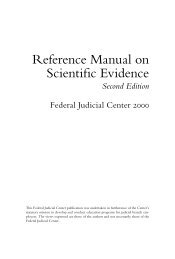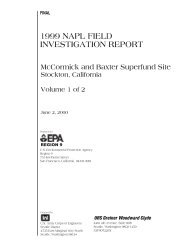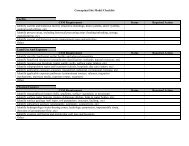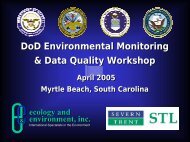Source Zone Delineation Demonstration Report - Triad Resource ...
Source Zone Delineation Demonstration Report - Triad Resource ...
Source Zone Delineation Demonstration Report - Triad Resource ...
You also want an ePaper? Increase the reach of your titles
YUMPU automatically turns print PDFs into web optimized ePapers that Google loves.
The position of the water table in May 2002 is shown on Figure 5-19 for reference. It is about 15 to 20feet lower than the lowest level of the 100 g/kg contour. Although the magnitude of water tablefluctuations over the past several decades are unknown, it seems unlikely they are in the range of 15 to 20feet. Thus the fluctuation of the groundwater surface through soils contaminated with TCE at a levelabove 100 g/kg does not appear to be a mechanism for contamination in the saturated zone, at least atthe location of this particular cross section.Figure 5-20 is a north-to-south vertical cross section at an easting of 1,856,100 feet, and orthogonal toFigure 5-19. The elongate character of contamination is evident. Note the shape of the 100 g/kgbetween northings of approximately 298,250 feet and 298,270 feet, and elevations of about 4540 to 4550feet. This tongue-shaped contour indicates transport to the south, and connects to a previously describedcontour suggesting an easterly component of transport on the east-west cross section at a northing of298,270 feet (see Figure 5-19). Some of the smaller, isolated regions of TCE contamination enclosed bythe 100 g/kg contour may be interpolation artifacts and should be interpreted with discretion (e.g., theregion at an elevation of approximately 4,525 feet between a northing of 298,360 feet and 298375 feet).Clearly connected migration pathways are less visible, although there is an apparent southwardcomponent of migration direction from the main region of contaminated soil.Volumetric calculations of soil type indicate that the proportions of soil types in the combined soil/TCEmodel are very similar to those in the site-wide model. Of the 124,444 yd 3 of soil in the combinedsoil/TCE model, 17% is sand, 53% is silty-sand, 27% is sandy-silt, and 3% is silt. More detailedcalculations describing the relationship between TCE contamination and soil type are summarized inTable 5-4. The calculations are based on the region enclosed by the 10 g/kg iso-concentration surface.30,472 yd 3 , or 24.5% of the model volume, is enclosed by the 10 g/kg iso-concentration surface. Theaverage concentration of TCE within this volume is 131.93 g/kg, yielding a mass of 12.5 lb and avolume of 0.202 ft 3 TCE. The bulk of the TCE is in silty-sand; 21.9% of the silty-sand is contaminatedby TCE at a concentration higher than 10 g/kg, with an average concentration of 343.8 g/kg, for a totalof 10.62 lb TCE (85% of the total). Analogous results for the other modeled soil types are listed in Table5-4.Table 5-4. Distribution of TCE Greater Than 10 µg/kg by Soil TypeSoil TypeVolume(yd 3 )Percent ofSoil-Type(%)TCE Volume(ft 3 )TCE Mass(lb)Average TCEConcentration(µg/kg)Sand 1,124 5.3 0.0013 0.08 34.05Silty-Sand 14,450 21.9 0.1715 10.62 343.80Sandy-Silt 13,895 41.6 0.0275 1.72 57.88Silt 1,003 24.8 0.0013 0.08 38.97TOTAL 30,472 24.5 0.2016 12.50 131.93March 2003 5-29 OU 12 <strong>Demonstration</strong> <strong>Report</strong>Final










